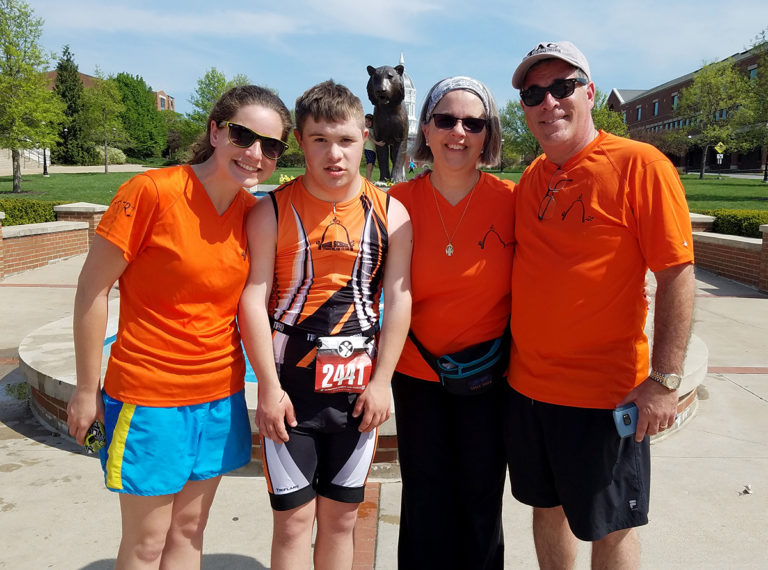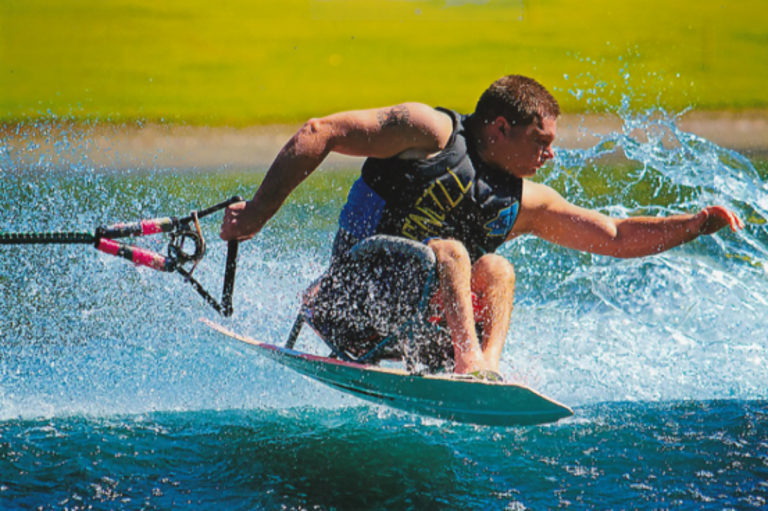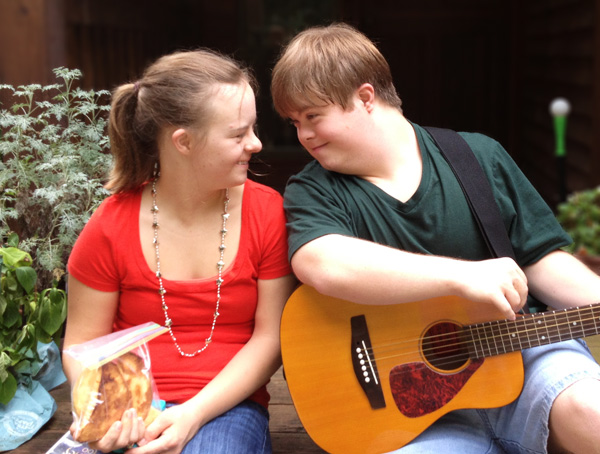An Impossible Dream?
By Ann B. Martin, mother of Katherine, UPPED
One day at church, a fellow parishioner observed my then 7 year old daughter’s awkward Galt, her flapping hands, and her loud wordless groans. She asked me if I had ever heard of the National Association for Child Development (NACD). This nationwide organization teaches parents how to utilize a multitude of therapies to create new neurological pathways in the brain of their impaired child thereby circumventing the injured or malfunctioning areas of the brain. It has helped more that 15,000 families over the past 20 years with everything from dyslexia to ADD to Downs Syndrome. This woman told me that the NACD program had worked wonders for her son who had been diagnosed with many neurological problems, and that it had literally “changed” his life. Always on the lookout for anything to help my child, I decided to look into it.
Angelman Syndrome consists of many neurological deficits. Yet, because it is genetically caused, I doubted that the program could work with my AS child as it had worked to solve her son’s non-genetic problems. But, putting aside my skepticism in favor of hopefulness, I contacted NACD headquarters in Utah to find when and where my daughter, Katherine, could be evaluated. Since there are five or six regional centers, I chose Atlanta for its proximity to Tampa. In March 1999, we met with Robert Doman, founder and head of NACD.
Within one hour Mr. Doman – experienced and perceptive – had correctly recognized each and every one of my daughter’s problems, from the orthopedic to the visual, from the muscular to the auditory. He told us in one session what we had gone to a multitude of specialists over the years to find out. Mr. Doman even pointed out Katherine’s auditory deficits which no doctor or therapist had ever mentioned. When we questioned where his program could help genetically-caused deficiencies and problems, he was confident it could. He pointed to all the work he had done with Downs children over the course of thirty years, starting when he was a special education teacher. The strides made over the years with Downs children, using nutritional support and a good neurodevelopmental program, were truly remarkable. He was sure Angelman children could likewise be helped.
Mr. Doman mapped out a program to address each and every deficiency, approximately 20 exercises to be at home four times a day, five days a week, fifty weeks a year. A counselor then described each exercise to us in detail, recording each one on audiotape as we went along. We were taught how to use the data sheet to mark and track each exercise as we completed it. At the end of each month, the data sheets for the previous four weeks would be mailed to NACD. There was a telephone number to call if we needed assistance or to discuss any difficulties. We were encouraged to go home, collect all the materials we would need, review the tape, learn the program, and get started on improving our child’s life.
Getting Started
About mid-April we began. I would get Katherine out of bed one hour early to get through one complete sequence. I added some relaxation music to cue her that this was program time. It took awhile to coordinate shower, dressing, eating, and program, but after a few mornings, we established a working pattern. The deep pressure and massage exercises we did while Katherine was still on the toilet. The various mouth stimulation/vocalization and visual exercises we did in the sunroom, along with spinning on a chair. The flash cards and language cards we completed right after breakfast at the table. The sit/stand and auditory sequences we were finishing up as the bus pulled up to take Katherine to school. But, by the time she got home, went for a brisk walk, played in the park, and ate supper, we only had time to complete one more sequence before bedtime, leaving a deficit of two entire sequences a day. Most NACD children are home-schooled so the program is interspersed throughout the entire day. What could I do? I was already home-schooling my middle school son and that was enough of a challenge. I couldn’t do both of them. Besides, Katherine loved her school, Dover Exceptional Student Center. There were four children in her class and she got lots of individual attention. Her IEP was coming up, so I decided to make my special request that as much of the NACD program as possible be integrated into her school day.
Cooperation of School
Katherine’s teacher and therapists were most receptive, realizing that the NACD program was entirely compatible with her IEP goals. I laid out the entire program for them, telling them that I would be responsible for maintaining and providing all materials and data sheets which I would send in each day in a special program bag. My husband and I made a video of the entire program to demonstrate how simple the exercises were. That video is kept in school to help new aides or volunteers to learn the program. I also have given in-service training to the staff. There was only one part of the program consisting of three exercises with which they felt uncomfortable, involving stimulating and probing the mouth and tongue. Given Katherine’s tendency to bite anything and everything that comes in contact with her mouth, I can’t say I blamed them. So that part of the program was earmarked for parents only. The rest became part of Katherine’s IEP, one complete session being done during the morning, the second in the afternoon during nap time when my daughter never slept anyway. So, beginning in late May 1999, the complete NACD program was administered daily to my child, twice at home and twice at school. On weekdays when school is not in session, we do all four sequences at home ourselves, except for major holidays and our own vacation time.
Re-evaluation
Every four months at a local center (Orlando for central Florida), NACD re-evaluates our child and alters the program as needed. Some exercises are increased or added, others are eliminated as she achieves neurological competence in them. We have had two re-evaluations. While Katherine has shown improvement in visual and motor skills, she still needs much more work in processing auditory information. That skill- auditory processing- is intimately liked to behavior with which AS children have lots of difficulty. According to the NACD, when a child can hear and process correctly two unrelated pieces of information, he/she will act like a two-year old; three pieces of information, like a three-year old; four pieces of information, etc. up to neurological completion at six years of age. Since Katherine’s auditory functioning level is one, NACD has increased our auditory sequences to 50 per day. In order to fit in so many double sequences, they cut back the rest of the program from four repetitions per day to two per day except for flash and language cards which remain the same. It is quite intensive and demanding, but absolutely essential to further neurological development.
I thought that my child heard and understood “everything.” Not so. She may hear it, but she does not remember or process well. When I say, “Touch nose, touch knee,” she does one or the other, seldom both. That means she is grasping only one piece of information out of two proffered. So I take her hands, moving them appropriately as I repeat the commands. Over and over again we do body parts; objects around the house; two-step commands like, “clap hands, stomp feet.” With the flash cards, I ask for two out of three displayed. She responds correctly about half the time. Sometimes I think she just guesses; other times she seems to really study the cards before choosing. NACD says that when she can sequence two unrelated things about 75% of the time, I should go on to three. Her behavior should improve as well.
The Listening Program (TLP)
The Listening Program is an add-on recommended particularly when auditory sequencing is a problem. It consists of specially-engineered classical music and nature sounds that exercise the full range of human hearing. For eight consecutive weeks, the child listens to a different CD weekly through high quality earphones. There are two 15-minute sessions daily. After a one month rest, the 8-week sequence is repeated. It has been noted that children completing TLP attend better to sounds in the environment, particularly the sounds of language.
Katherine has completed her second round of TLP. We have noticed lots of spontaneous vocalizations not heard before; she is also making progress replicating the sounds of letters. She can correctly copy on command about 14 phonemes, the smallest unit in the sound system of language. Since there are 44 phonemes in the English Language, we have a long way to go. When her audio-processing reaches 2 or 3, we hope she can start combining sounds to form real words.
The Sleeping Problem
When I first complained to NACD about Katherine’s poor sleep patterns, they recommended total sensory deprivation during the night. We boarded up her window and caulked it so that not a speck of light comes through. The ceiling light has a cut-off switch, and a draft doggie is placed outside her bedroom door after we lock it so no light comes under the door. That room is dark as a cave. NACD said to put every toy out of reach giving her nothing to play with if she does wake up during the night. The only thing we permit is soft soothing music via the intercom.
For most of this past year, Katherine has been sleeping through the night. She sleeps on a mattress near the floor and has total mobility within the confines of her room. Many mornings she’s till in bed where we put her the night before. Although she sometimes still has a restless night, there is no more wrecked room; no more drapes torn off the window; no more toys strewn about. Total darkness has worked much better than melatonin, Benedryl, or any other thing we have tried. We believe that by sleeping well at night, Katherine is better able to make progress during the day both in school and with program. We also believe her brain is forming a proper sleep pattern. A few weeks ago we stayed in a hotel for two nights. Katherine was in a regular double bed by herself. She slept through the night without getting up and wandering about, even though some light filtered into the room from the street lamps. Her brain is developing a normal sleep rhythm.
Results
What have been the results of nearly a year on program? Katherine no longer needs orthotics or eyeglasses. Our daughter is a patient at Shriners; she wore AFO’s due to a twin in her left foot and the tendency to walk on the outsides of her feet. NACD told us to “lose” the orthotics and substitute 1/4 inch lateral wedge on the outer part of her sneakers from toe to heel. They said the orthotics were not correcting the problem, merely keeping it from getting worse. Dubiously, I took that information to Shriners for verification. They confirmed that the braces were not corrective. I told them I wanted correction; they agreed to try the wedges. Katherine’s gait has improved remarkably. She seems more sure-footed as she transfers from one surface to another. She is going on tip-toes for the first time ever, and is beginning to run. The brisk daily walks have built up her muscle tone and confidence. On March 25, 2000, Katherine won the gold medal at the Sun Coast Special Olympics Summer Games in the 25 meter track and field event for 8 to 11 year olds. She did 25 meters in 28 seconds against three older and larger opponents. We couldn’t believe it!
Katherine has been wearing prism lenses since she was four years old to compensate for the visual distortion AS children have due to poor frontal vision. NACD recommended specific visual exercises along with the use of pinhole glasses when watching television or doing computer work to stimulate and focus the eye thereby improving frontal vision. For years her teachers had said that Katherine attended better to her work with her eyeglasses than without. In February, NACD said to try schoolwork without the prism lenses. Her teacher reports that Katherine is doing just as well in class without the eyeglasses, and when walking or bike riding she is doing better without the glasses. We are making visual progress!
Generally, Katherine likes the one-on-one interaction with the program. But, at first, there were parts of the program she didn’t like: the massage of the soles of her feet and the palms of her hands was too intense; the probing and pulling of her tongue made her gag; she got frustrated with the language cards when she couldn’t produce the beginning sounds. However, we persisted. Now she looks forward to program even bringing me flash cards on the weekends when we have time off. She especially looks forward to TLP, a soothing and relaxing time when she colors, does puzzles, or traces sandpaper letters while listening.
Do we complete each part of the program every day? We try. But, sometimes due to illness or some event, we just cannot. That’s okay. Doing part of the program is better than doing nothing.
Why Does the Program Work?
Why does the NACD program work when each exercise is only one to two minutes duration? When there are no complicated, innovative, or remarkable exercises? When no special expensive equipment is required? When any parent can learn to do it? The answer lies in the frequency, intensity, and duration upon which the program depends. We need to create new neural pathways in our AS child’s brain to compensate for whatever is damaged. Placing these special needs children in school- even the best school- where they will get therapy only once or twice per week, cannot possibly do the job. The skill has got to be presented on a frequent and consistent basis. Four times a day, five days a week, makes 20 times a week, totaling a thousand times a year. With so much input, the brain finally “gets” it. New neural connections are established and start working. Progress is made, as the child moves up the neurological chart towards more complex functioning.
Our AS children need to move past the one-to two year old level in which they seem to be imprisoned. It can be done. Downs children were once thought to be unteachable and unreachable; thousands were institutionalized. Now many attend regular classes in public schools working at or near grade level. Why not Angelman children? I truly believe the NACD program has the potential to do it. But, we parents need to make the commitment and do the work. It will take years. But, imagine if our Angels can be taught to read? To write? To speak? They need never spend their lives in an institution or totally dependent on others. They could actually function in this world.
Is it really an impossible dream?
Florida
The Race
By Ann MartinStanding at the line,
Watching the crowd watching me,
Wondering what is expected of me,
I hear the whistle blow.
A burst of energy and they’re off!
I’m confused. Why am I here?
Where do I go? What do I do?
From the sidelines mother shouts: RUN!
My ears perk up. Determined
My legs stiffen, my arms flail as my feet flap
Faster, faster to the finish line.
Strangers slap my back and say, “Well done!”
I smile with the joy at my accomplishment.
In a moment I hear,
“The winner- first place….”
It’s me!
They place the gold around my neck
And tell me I’m the champion!
My arm reaches over my head
In a victory salute
For the Special Olympics- and myself.




